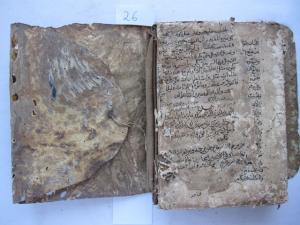The Manuscript Collection of the Riyadha Mosque, Lamu, Kenya
By Dr. Anne K. Bang
The Riyadha Mosque in Lamu, Kenya, is one of the longest continuously functioning and one of the most influential Islamic teaching institutions in the Swahili world. The first time I heard about the Riyadha Mosque of Lamu, was – typically – neither in Kenya nor in East Africa, but in Hadramawt, Yemen. More precisely, I was in the city of Sayun, in a public building overlooking the Riyadha Mosque there, founded in 1879 by Ali al-Hibshi. The Riyadha of Sayun is both the namesake and the model for the Lamu Riyadha and the relationship between the two institutions remained strong. The Lamu Riyadha was founded in the late 19th century by Salih b. Alawi Jamal al-Layl (1853/53-1936), based on the teaching taking place in the Riyadha in Sayun – particularly the mawlid celebrations implemented by Ali al-Hibshi.

The official who pointed it out to me knew that I was particularly interested in Hadrami-East African relations, and he slowly and carefully explained to me that there is “another Riyadha” in Lamu. My Arabic being fragmentary, I understood him to mean that Lamu was a paradise-like place, like “another Garden” somewhere.
Later, as I started my work in East Africa, I came to know the Riyadha well, its history and its role in changes taking place in East African Islam. However, it was to take 15 years before I actually came to Lamu.
The Riyadha, in the course of its approximately 120 years of existence, and with its “branches” in other parts of the region, has come to epitomize in East Africa what has been called the regionally evolved and dominant religious doctrine and practice of Islam. Drawing on wider links with the Hadramawt (Yemen) as well as regional collaboration as far south as the Comoro Islands, the impact of the Riyadha on Islamic intellectual history in East Africa cannot be underestimated. Today, the institution educates children from the entire Lamu archipelago as well as advanced students from all over East Africa in the regular madrasa (mosque school) and its Muslim Academy which now houses approximately 50 students. The long history of the Riyadha as a teaching institution is reflected in its rich library located on the mosque premises.
The manuscript collection of the Riyadha Mosque
The collection consists of approximately 120 manuscripts, dating from the 1850s to the early 1920s, i.e. the period just before the transition to print circulation of Islamic scriptural material in East Africa. The manuscripts range from 400-page tomes of Islamic law to smaller leaflets of 40-50 pages meant for an educational setting. Most are in Arabic, but several also have interlinear translations/commentaries to Swahili in the Arabic script. Most are bound in leather.
The manuscript collection of the Riyadha mosque is unique from several perspectives. Firstly, it provides an important overview of the historical orientation of Islamic education in East Africa. The collection also contains works that can be found nowhere else. One example is the Kitāb al-Sarf by the 19th century scholar Muḥyī al-Dīn al-Qaḥṭānī, of which this is the only known copy.

Several of the manuscripts have inscriptions that name owners over decades, indicating the economy of books. Finally, the presence in many of the manuscripts of inter-linear Swahili translations in the Arabic script opens for research on the use of the Arabic script before colonial education. Thus, both from a research perspective and from the point of view of literary and cultural value, the manuscript collection of the Riyadha Mosque forms a unique part of Kenyan, East African and African Islamic heritage.
A preliminary survey of the manuscript collection was carried out in July 2010. The initial survey revealed that the Riyadha holds several manuscripts that until now have been considered “lost” in the region. The survey also made clear the poor state of repair of the manuscripts - broken leather bindings, fading ink, paper eaten by insects and fungus damage. It is currently kept in a cupboard without adequate security or a full index, in a room with no air-conditioning.
A project has been proposed to the British Library Endangered Archives Programme and to the Ministry for Foreign Affairs of Norway to fully digitalize the manuscript collection held at the Riyadha mosque (funding is still pending). The proposal is a joint project between Dr. A. Bang, Chr. Michelsen Institute, and Dr. S. Jeppie, University of Cape Town, in collaboration with other scholars from both institutions. Important contact points for this project have been Aydarus and Ahmad Muhsin Badawi, descendants of the founder of the Riyadha, and currently responsible for the teaching facilities of the mosque. They are both educated Islamic scholars after 6 years training in the Dar al-Mustafa in Tarim, Yemen. Their expertise and profound knowledge of both the Islamic scriptural tradition and the Riyadha itself, is vital to the success of the project. Pending funding, the project will start in November 2011.
Dr. Anne K. Bang is a senior researcher at the Chr. Michelsen Institute, Norway.